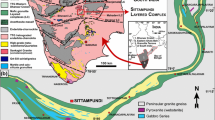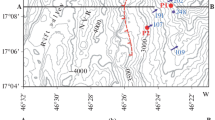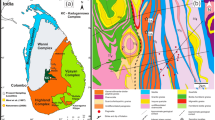Abstract
Textural and mineral–chemical characteristics in the Bangriposi wehrlites (Eastern India) provide insight into metamorphic processes that morphologically and chemically modified magmatic spinel during serpentinization of wehrlite. Aluminous chromite included in unaltered magmatic olivine is chemically homogenous. In sub-cm to 10s-of-micron-wide veins, magnetite associated with antigorite and clinochlore comprising the serpentine matrix is near-stoichiometric. But Al–Cr–Fe3+ spinels in the chlorite–magnetite veins are invariably zoned, e.g., chemically homogenous Al-rich chromite interior successively mantled by ferritchromite/Cr-rich magnetite zone and magnetite continuous with vein magnetite in the serpentine matrix. In aluminous chromite, ferritchromite/Cr-rich magnetite zones are symmetrically disposed adjacent to fracture-controlled magnetite veins that are physically continuous with magnetite rim. The morphology of ferritchromite–Cr-rich magnetite mimics the morphology of aluminous chromite interior but is incongruous with the exterior margin of magnetite mantle. Micropores are abundant in magnetite veins, but are fewer in and do not appear to be integral to the adjacent ferritchromite–Cr-rich magnetite zones. Sandwiched between chemically homogenous aluminous chromite interior and magnetite mantle, ferritchromite–Cr-rich magnetite zones show rim-ward decrease in Cr2O3, Al2O3 and MgO and complementary increase in Fe2O3 at constant FeO. In diffusion profiles, Fe2O3–Cr2O3 crossover coincides with Al2O3 decrease to values <0.5 wt% in ferritchromite zone, with Cr2O3 continuing to decrease within magnetite mantle. Following fluid-mediated (hydrous) dissolution of magmatic olivine and olivine + Al–chromite aggregates, antigorite + magnetite and chlorite + magnetite were transported in 10s-of-microns to sub-cm-wide veins and precipitated along porosity networks during serpentinization (T: 550–600 °C, f(O2): −19 to −22 log units). These veins acted as conduits for precipitation of magnetite as mantles and veins apophytic in chemically/morphologically modified magmatic Al-rich chromite. Inter-crystalline diffusion induced by chemical gradient at interfaces separating aluminous chromite interiors and magnetite mantles/veins led to the growth of ferritchromite/Cr-rich magnetite zones, mimicking the morphology of chemically modified Al–Cr–Fe–Mg spinel interiors. Inter-crystalline diffusion outlasted fluid-mediated aluminous chromite dissolution, mass transfer and magnetite precipitation.










Similar content being viewed by others
References
Abzalov MZ (1998) Chrome–spinels in gabbro–wehrlite intrusions of the Pechenga area, Kola Peninsula, Russia: emphasis on alteration features. Lithos 43:109–134
Arai S, Shimizu Y, Ismail SA, Ahmed AH (2006) Low-T formation of high-Cr spinel with apparently primary chemical characteristics within podiform chromitite from Rayat, northeastern Iraq. Mineral Mag 70:499–508
Asimow PD, Ghiorso MS (1998) Algorithmic modifications extending MELTS to calculate subsolidus phase relations. Am Mineral 83:1127–1131
Ballhaus C, Berry RF, Green DH (1991) High pressure experimental calibration of the olivine–orthopyroxene–spinel oxygen geobarometer: implications for the oxidation state of the upper mantle. Contrib Mineral Petrol 107:27–40
Barnes SJ (1998) Chromite in komatiites, 1. Magmatic controls on crystallization and composition. J Petrol 39:1689–1720
Barnes SJ (2000) Chromite in komatiites, II. Modification during greenschist to mid-amphibolite facies metamorphism. J Petrol 41:387–409
Barnes SJ, Roeder PL (2001) The range of spinel compositions in terrestrial mafic and ultramafic rocks. J Petrol 42:2279–2302
Beard JS, Frost BR, Fryer P, McCaig A, Searle R, Ildefonse B, Zinin P, Sharma SK (2009) Onset and progression of serpentinization and magnetite formation in olivine-rich troctolite from IODP hole U1309D. J Petrol 50:387–403
Bjerg EA, de Brodtkorv MK, Stumpfl EL (1993) Compositional zoning in Zn chromites from the Cordillera Frontal Range, Argentina. Mineral Mag 57:131–139
Bliss NW, MacLean WH (1975) The paragenesis of zoned chromite from central Manitoba. Geochim Cosmochim Acta 39:973–990
Burkhard DJM (1993) Accessory chromian spinels: their coexistence and alteration in serpentinites. Geochim Cosmochim Acta 57:1297–1306
Dick HJB, Bullen T (1984) Chromian spinel as petrogenetic indicator in abyssal and alpine-type peridotites and spatially associated lavas. Contrib Mineral Petrol 86:54–76
Fabries J (1979) Spinel-olivine geothermometry in peridotites from ultramafic complexes. Contrib Mineral Petrol 69:329–336
Farahat ES, Hoinkes G, Mogessie A (2011) Petrogenetic and geotectonic significance of Neoproterozoic suprasubduction mantle as revealed by the Wizer ophiolite complex, Central eastern desert, Egypt. Int J Earth Sci (Geol Rundsch) 100:1433–1450
Frost BR (1985) On the stability of sulfides, oxides, and native metals in serpentinite. J Petrol 26:31–63
Gahlan FA, Arai S (2007) Genesis of peculiarly zoned Co, Zn and Mn-rich chromian spinel in serpentinite of Bou-Azzher ophiolite, Anti-Atlas, Morroco. J Mineral Petrol Sci 102:69–85
Gervilla F, Padron-Navarta JA, Kerestedjian T, Sergeeva I, Gonzalez-Jimenez JM, Fanlo I (2012) Formation of ferrian chromite in podiform chromitites from the Golyamo Kamenyane serpentine, Eastern Rhodopes, SE Bulgaria: a two-stage process. Contrib Mineral Petrol 164:643–657
Ghiorso MS, Sack RO (1995) Chemical mass transfer in magmatic processes. IV. A revised and internally consistent thermodynamic model for the interpolation and extrapolation of liquid-solid equilibria in magmatic systems at elevated temperatures and pressures. Contrib Mineral Petrol 119:197–212
Hajialioghli R, Moazzen M, Droop GTR, Oberhänsli R, Bousquet R, Jahangiri A, Ziemann M (2007) Serpentine polymorphs and P–T evolution of metaperidotites and serpentinites in the Takab area, NW Iran. Mineral Mag 71:203–222
Hyndman DW (1985) Petrology of igneous and metamorphic rocks, 2nd edn. McGraw-Hill Book, New York, pp 550–562
Kapsiotis A, Tsikouras B, Gramatikopoulos T, Karipi S, Hatzipanagiotou K (2007) On the metamorphic modification of Cr-spinel compositions from the ultrabasic rocks of the Pindos ophiolite complex (NW Greece). Bull Geol Soc Greece 40:781–793
Kepezhinskas PK, Taylor RN, Tanaka H (1993) Geochemistry of plutonic spinels from the North Kamchatka arc: comparisons with spinel from other tectonic settings. Mineral Mag 576:575–589
Khedr Z, Arai S (2010) Hydrous peridotites with Ti-rich chromian spinel as a low-temperature forearc mantle facies: evidence from the Happo-O’ne metaperidotites (Japan). Contrib Mineral Petrol 159:137–157
Kimball KL (1990) Effects of hydrothermal alteration on the compositions of chromian spinels. Contrib Mineral Petrol 105:337–346
Kretz R (1973) Kinetics of the crystallization of garnet at two localities near Yellowknife. Can Mineral 12:1–20
Kretz R (1983) Symbols for rock-forming minerals. Am Mineral 68:277–279
Leake BE, Woolley AR, Arps CES, Birch WD, Gilbert MC, Grice JD, Hawthorne FC, Kato A, Kisch HJ, Krivovichev VG, Linthout K, Laird J, Mandarino J, Maresch WV, Nickel EH, Rock NMS, Schumacher JC, Smith DC, Stephenson NCN, Ungaretti L, Whittaker EJW, Youzhi G (1997) Nomenclature of Amphiboles: report of the subcommittee on amphiboles of the International Mineralogical Association Commission on New Minerals and Mineral Names. Mineral Mag 61:295–321
Loferski PJ (1986) Petrology of metamorphosed chromite bearing rocks from the Red Lodge District, Montana. US Geol Surv Bull 1626-B:B1–B34
Merlet C (1992) Quantitative electron probe microanalysis: new accurate Φ(ρz) description. Mikrochim Acta 12:107–115
Merlet C (1994) An accurate computer correction program for quantitative electron probe microanalysis. Mikrochim Acta 114/115:363–376
Mondal SK, Ripley EM, Li C, Ahmed AH, Arai S, Liipo J, Stowe C (2003) Oxygen isotopic compositions of Cr-spinels from Archean to Phanerozoic chromite deposits. Goldschmidt conference at Japan, abstract with program. Geochim Cosmochim Acta 18S:A301
Mukherjee R, Mondal SK, Rosing MT, Frei R (2010) Compositional variations in the Mesoarchean chromites of the Nuggihalli schist belt, western Dharwar Craton (India): potential parental melts and implications for tectonic setting. Contrib Mineral Petrol 160:865–885
Nozaka T (2003) Compositional heterogeneity of olivine in thermally metamorphosed serpentinite from Southwest Japan. Am Mineral 88:1377–1384
Ozawa K (1988) Stress-induced Al–Cr zoning of spinel in deformed peridotites. Nature 338:141–144
Prabhakar N, Bhattacharya A, Mukherjee PK (2013) Chloritoid–mica shimmer aggregates of Bangriposi, Eastern India: formation by open system fluid-aided element transfer and dissolution-precipitation in open channels. J Petrol (under review)
Rakovan J, Jaszczak JA (2002) Multiple length scale growth spirals on metamorphic graphite 001 surfaces studies by atomic force microscopy. Am Mineral 87:17–24
Roeder PL, Campbell IH, Jamieson HE (1979) A re-evaluation of olivine–spinel geothermometer. Contrib Mineral Petrol 68:325–334
Sack RO, Ghiorso MS (1991) Chromian spinels as petrogenetic indicators: thermodynamic and petrologic applications. Am Mineral 76:827–847
Suzuki AM, Yasuda A, Ozawa K (2008) Cr and Al diffusion in chromite spinel: experimental determination and its implication for diffusion creep. Phys Chem Miner 35:433–445
Ulmer P, Trommsdorff V (1995) Serpentine stability to mantle depth and subduction related magmatism. Science 268:858–861
van Orman JA, Crispin KL (2010) Diffusion in Oxides. Rev Mineral Geochem (Mineral Soc Am) 72:757–782
Vernon RH (1999) Quartz and feldspar microstructures in metamorphic rocks. Can Minerol 37:513–524
Wylie AG, Candela PA, Burke TM (1987) Compositional zoning in unusual Zn-rich chromite from the Sykesville District of Maryland and its bearing on the origin of “ferritchromite”. Am Mineral 72:413–422
Acknowledgments
The present work is the part of the doctoral dissertation of the first author. P.N. acknowledges the financial support from the Council of Scientific and Industrial Research (India) during his tenure as research fellow. A.B. is thankful to the Indian Institute of Technology, Kharagpur (India) for providing CPDA funds during field work. Mineral analyses were performed in the DST-IRHPA funded Electron Probe Micro-analytical Facility, Department of Geology and Geophysics, Indian Institute of Technology, Kharagpur. We thank Prof. B. Mishra for assisting with laser Raman analyses. P.N. acknowledge Suresh Telu for his help with XRD analyses. We thank two anonymous journal reviewers for their thoughtful and inspired comments in earlier version of the manuscript. Their comments improved both the style of presentation and the scientific content of the manuscript. However, we are responsible for any errors that may have persisted in spite of our best efforts. T. L. Grove is thanked for his editorial handling of the manuscript.
Author information
Authors and Affiliations
Corresponding author
Additional information
Communicated by T. L. Grove.
Electronic supplementary material
Below is the link to the electronic supplementary material.
410_2013_909_MOESM1_ESM.tif
Data Repository1: Laser Raman spectra of serpentine in matrix (replacing olivine) and in veins in AL-24 (details in text and Fig. 8b) in the right panel are compared with reference antigorite, lizardite and chrysotile (http://www.rruff.info) in left panel
Appendix: Analytical procedure
Appendix: Analytical procedure
Quantitative mineral analyses were carried out using 4-channel WDS CAMECA SX-100 electron probe microanalyzer. The analytical conditions were 20-kV accelerating voltage, 30-nA beam current and 1-um-beam diameter. Both natural and synthetic standards were used for calibrating Si, Al, Mg, Ti, Cr, Mn, Fe, Na, Ca and Zn, whereas V, Co and Ni were quantified using pure metal standards. The counting for time peak and background analysis was between 10 s and 20 s depending on elements, with half the peak time allocated for background analyses. Spectral interference of Na K a on Zn L b , V K a on Ti K b , Zn K b and Cr K a on V K b were corrected, and X-PHI method (Merlet 1992, 1994) was used for matrix correction. Detailed calibration setting is tabulated below.
Calibration setting for all mineral analyses
Element line | Crystal | Peak time (s) | Background (−ve) | Background (+ve) | Slope/IBg | Background time (s) | Standard | Standard intensity (cps/nA) | PHA control mode |
|---|---|---|---|---|---|---|---|---|---|
Na K a | TAP | 10 | ··· | 600 | 1.1 | 5 | Jadeite | 123 | Integral |
Mg K a | TAP | 10 | ··· | 1,200 | 1.16 | 5 | MgO | 1,535 | Integral |
Al K a | TAP | 10 | ··· | 600 | 1.1 | 5 | Al2O3 | 1,796 | Integral |
Si K a | TAP | 10 | ··· | 600 | 1.1 | 5 | CsGlass | 800 | Integral |
Ca K a | PET | 10 | ··· | 500 | 1.1 | 5 | Diopside | 205 | Integral |
Ti K a | LPET | 20 | ··· | 500 | 1.1 | 10 | TiO2 | 2,701 | Integral |
V K a | LPET | 20 | −650 | 650 | ··· | 10 | V | 5,294 | Integral |
Cr K a | LIF | 10 | ··· | 500 | 1.1 | 5 | Cr2O3 | 177 | Integral |
Mn K a | LIF | 10 | ··· | 500 | 1.1 | 5 | Rhodonite | 82 | Integral |
Fe K a | LIF | 10 | ··· | 500 | 1.1 | 5 | Fe2O3 | 187 | Integral |
Co K a | LIF | 20 | −1,300 | 500 | ··· | 10 | Co | 277 | Integral |
Ni K a | LIF | 20 | ··· | 600 | 1.05 | 10 | Ni | 257 | Integral |
Zn K a | LIF | 20 | ··· | 500 | 1.1 | 10 | ZnS | 121 | Integral |
Rights and permissions
About this article
Cite this article
Prabhakar, N., Bhattacharya, A. Origin of zoned spinel by coupled dissolution–precipitation and inter-crystalline diffusion: evidence from serpentinized wehrlite, Bangriposi, Eastern India. Contrib Mineral Petrol 166, 1047–1066 (2013). https://doi.org/10.1007/s00410-013-0909-y
Received:
Accepted:
Published:
Issue Date:
DOI: https://doi.org/10.1007/s00410-013-0909-y




